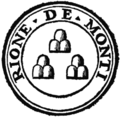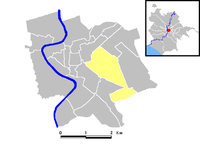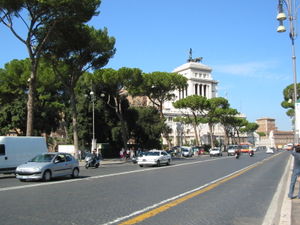
Monti (rione of Rome)
Encyclopedia



Rioni of Rome
A rione is an Italian term used since the Middle Ages to name the districts of Rome, according to the administrative divisions of that time. The word originates from the Latin word regio A rione (pl. rioni) is an Italian term used since the Middle Ages to name the districts of Rome, according to...
, rione I. The name literally means mountains in Italian and comes from the fact that the Esquiline
Esquiline Hill
The Esquiline Hill is one of the celebrated Seven Hills of Rome. Its southern-most cusp is the Oppius .-Etymology:The origin of the name Esquilino is still under much debate. One view is that the Hill was named after the abundance of holm-oaks, exculi, that resided there...
and the Viminal Hill
Viminal Hill
The Viminal Hill is the smallest of the famous seven hills of Rome. A finger-shape cusp pointing toward central Rome between the Quirinal Hill to the northwest and the Esquiline Hill to the southeast, it is home to the Teatro dell'Opera and the Termini Railway Station.At the top of Viminal Hill...
s, and parts of the Quirinal
Quirinal Hill
The Quirinal Hill is one of the Seven Hills of Rome, at the north-east of the city center. It is the location of the official residence of the Italian Head of State, who resides in the Quirinal Palace; by metonymy "the Quirinal" has come to stand for the Italian President.- History :It was...
and the Caelian Hill
Caelian Hill
The Caelian Hill is one of the famous Seven Hills of Rome. Under reign of Tullus Hostilius, the entire population of Alba Longa was forcibly resettled on the Caelian Hill...
s belonged to this rione. Its logo consists of three green mountains with three tops on a silver background.
Today the Esquilino, Castro Pretorio
Castro Pretorio
Castro Pretorio is the XVIII rione of Rome. The logo is the golden banner of the Praetorian Guard on a red background. The rione takes its name by the ruins of the Castrum Praetorium, the barracks of the Praetorian Guard, included in the Aurelian Walls....
and Celio
Celio
-People:*Enrico Celio , Swiss politician*Elton Divino Celio , Brazilian football player known as Eltinho*Gaspare Celio , Italian painter*Nello Celio , Swiss politician-Places:Italy...
districts do not belong to it anymore, but it has kept its former name.
In ancient times the rione was densely populated: in Monti there were the Forum Romanum and the so called Suburra
Suburra
Suburra is an area of the city of Rome, Italy. In ancient Roman times, it was a crowded lower-class area that was also notorious as a red-light district. It lies in the dip between the southern end of the Viminal and the western end of the Esquiline hills...
(meaning suburbs in Latin): this was the place poor people lived, full of disreputable locals and brothels.
In the Middle Ages
Middle Ages
The Middle Ages is a periodization of European history from the 5th century to the 15th century. The Middle Ages follows the fall of the Western Roman Empire in 476 and precedes the Early Modern Era. It is the middle period of a three-period division of Western history: Classic, Medieval and Modern...
the situation was completely different: the Roman aqueducts were damaged, and it was very difficult to bring water to Monti since it was on the hills. Hence many inhabitants moved to Campus Martius
Campus Martius
The Campus Martius , was a publicly owned area of ancient Rome about in extent. In the Middle Ages, it was the most populous area of Rome...
, a lower level part, where they could drink the water from the river Tiber
Tiber
The Tiber is the third-longest river in Italy, rising in the Apennine Mountains in Emilia-Romagna and flowing through Umbria and Lazio to the Tyrrhenian Sea. It drains a basin estimated at...
.
From the Middle Ages to the beginning of the 19th century, the rione remained an area full of vineyards and market gardens. Monti was not densely populated because of the lack of water and because it was quite far from the Vatican
Vatican City
Vatican City , or Vatican City State, in Italian officially Stato della Città del Vaticano , which translates literally as State of the City of the Vatican, is a landlocked sovereign city-state whose territory consists of a walled enclave within the city of Rome, Italy. It has an area of...
, the center of Christian culture. The area did not become abandoned thanks to the church of San Giovanni in Laterano and the constant high number of pilgrims.
Still in the Middle Ages the inhabitants of Monti, called monticiani, developed a strong identity: their Roman dialect was different from that spoken in the other rioni. Their main enemies were the people from the other rione with a strong identity, Trastevere
Trastevere
Trastevere is rione XIII of Rome, on the west bank of the Tiber, south of Vatican City. Its name comes from the Latin trans Tiberim, meaning literally "beyond the Tiber". The correct pronunciation is "tras-TEH-ve-ray", with the accent on the second syllable. Its logo is a golden head of a lion on a...
, and they often used to fight with one another.
Then, with growing urbanization at the end of the 19th century after Rome had become the capital of a united Italy, the great changes of the Fascist period completely changed the appearance of the rione. In particular, between 1924 and 1936, a large part of the rione, consisting of small streets and popular houses, was destroyed to make way for the Via dei Fori Imperiali
Via dei Fori Imperiali
The Via dei Fori Imperiali is a road in the centre of the city of Rome, Italy, that runs in a straight line from the Piazza Venezia to the Colosseum....
(the street artificially dividing the Roman Forum
Roman Forum
The Roman Forum is a rectangular forum surrounded by the ruins of several important ancient government buildings at the center of the city of Rome. Citizens of the ancient city referred to this space, originally a marketplace, as the Forum Magnum, or simply the Forum...
and most of the Imperial forums
Imperial forums
The Imperial Fora consist of a series of monumental fora , constructed in Rome over a period of one and half centuries, between 46 BC and 113 AD. The forums were the center of the Roman Republic and of the Roman Empire.The Imperial forums, while not part of the Roman Forum, are located relatively...
) and the archaeological buildings of the Forum Romanum were excavated.
Thanks to its position, Monti is full of archaeological sites such as:
- ColosseumColosseumThe Colosseum, or the Coliseum, originally the Flavian Amphitheatre , is an elliptical amphitheatre in the centre of the city of Rome, Italy, the largest ever built in the Roman Empire...
- Ludus MagnusLudus MagnusThe Ludus Magnus or The Great Gladiatorial Training School is the largest of the gladiatorial arenas in Rome, Italy. It was built by the emperor Domitian in the valley between the Esquiline and the Caelian hills, an area already occupied by Republican and Augustan structures...
(the gym for gladiatorGladiatorA gladiator was an armed combatant who entertained audiences in the Roman Republic and Roman Empire in violent confrontations with other gladiators, wild animals, and condemned criminals. Some gladiators were volunteers who risked their legal and social standing and their lives by appearing in the...
s) - NeroNeroNero , was Roman Emperor from 54 to 68, and the last in the Julio-Claudian dynasty. Nero was adopted by his great-uncle Claudius to become his heir and successor, and succeeded to the throne in 54 following Claudius' death....
's Domus AureaDomus AureaThe Domus Aurea was a large landscaped portico villa, designed to take advantage of artificially created landscapes built in the heart of Ancient Rome by the Emperor Nero after the Great Fire of Rome had cleared away the aristocratic dwellings on the slopes of the Palatine... - the baths of TrajanBaths of TrajanThe Baths of Trajan were a massive thermae, a bathing and leisure complex, built in ancient Rome starting from 104 AD and dedicated during the Kalends of July in 109...
- the baths of TitusBaths of TitusThe Baths of Titus were public baths built in Rome in 81 by Emperor Titus.The baths sat in the base of the Esquiline hill, an area of parkland and luxury estates which had been taken over by Nero for his Golden House or Domus Aurea...
- part of the Forum Romanum
- markets of Trajan
Churches
- Sant'Agata dei GotiSant'Agata dei GotiSant'Agata dei Goti is a church in Rome, Italy, dedicated to the martyr Saint Agatha. It is currently the titular church assigned to Cardinal Raymond Leo Burke, currently Prefect of the Supreme Tribunal of the Apostolic Signatura.-History:...
- Sant'Andrea al QuirinaleSant'Andrea al QuirinaleThe Church of Saint Andrew's at the Quirinal is a Roman Catholic titular church in Rome, built for of the Jesuit seminary on the Quirinal Hill....
- San Carlo alle Quattro FontaneSan Carlo alle Quattro FontaneThe Church of Saint Charles at the Four Fountains is a Roman Catholic church in Rome, Italy. Designed by the architect Francesco Borromini, it was his first independent commission. It is an iconic masterpiece of Baroque architecture, built as part of a complex of monastic buildings on the Quirinal...
- San ClementeBasilica di San ClementeThe Basilica of Saint Clement is a Roman Catholic minor basilica dedicated to Pope Clement I located in Rome, Italy. Archaeologically speaking, the structure is a three-tiered complex of buildings: the present basilica built just before the year 1100 during the height of the Middle Ages; beneath...
- Santa Maria dei Monti
- Santa Maria Maggiore
- San Martino ai MontiSan Martino ai MontiSan Martino ai Monti, also known as Santi Silvestro e Martino ai Monti - Titolo Equizio, is a basilica church in Rome, Italy, in the Rione Monti neighbourhood.-History:...
- Santa PrassedeSanta PrassedeThe Basilica of Saint Praxedes , commonly known in Italian as Santa Prassede, is an ancient titular church and minor basilica in Rome, Italy, located near the papal basilica of Saint Mary Major...
- San Pietro in VincoliSan Pietro in VincoliSan Pietro in Vincoli is a Roman Catholic titular church and minor basilica in Rome, Italy, best known for being the home of Michelangelo's statue of Moses, part of the tomb of Pope Julius II.-History:...
- Santa PudenzianaSanta PudenzianaThe basilica of Santa Pudenziana is a 4th century church in Rome, dedicated to Saint Pudentiana, sister of Saint Praxedis and daughter of Saint Pudens. It is the national church of the Philippines....
- Santi Quirico e GiuliettaSanti Quirico e GiuliettaThe chiesa dei Santi Quirico e Giulitta is a church on via Tor de’ Conti in the Monti rione of Rome. It is dedicated to Quiricus and Julietta, two 4th century martyrs.-History:...
- Santo Stefano RotondoSanto Stefano RotondoThe Basilica of St. Stephen in the Round on the Celian Hill is an ancient basilica and titular church in Rome, Italy. Commonly named Santo Stefano Rotondo, the church is the National church in Rome of Hungary dedicated to Saint Stephen and Saint Stephen of Hungary...
- San Vitale
- San Giovanni in Laterano
- Santi Marcellino e PietroSanti Marcellino e PietroSanti Marcellino e Pietro al Laterano is a Roman catholic parish and titular church in Rome on the Via Merulana. It is dedicated to Saints Marcellinus and Peter, 4th century Roman martyrs, whose relics were brought here in 1256.-History:...
- Santa Lucia in Selci

